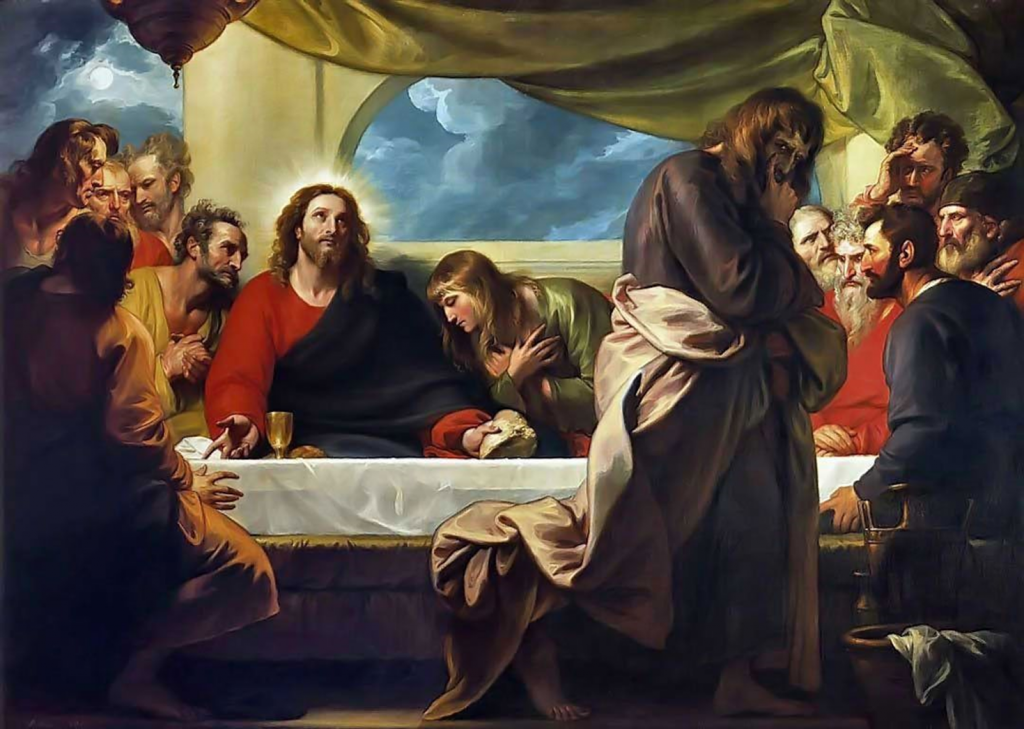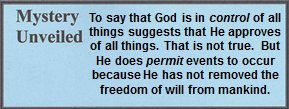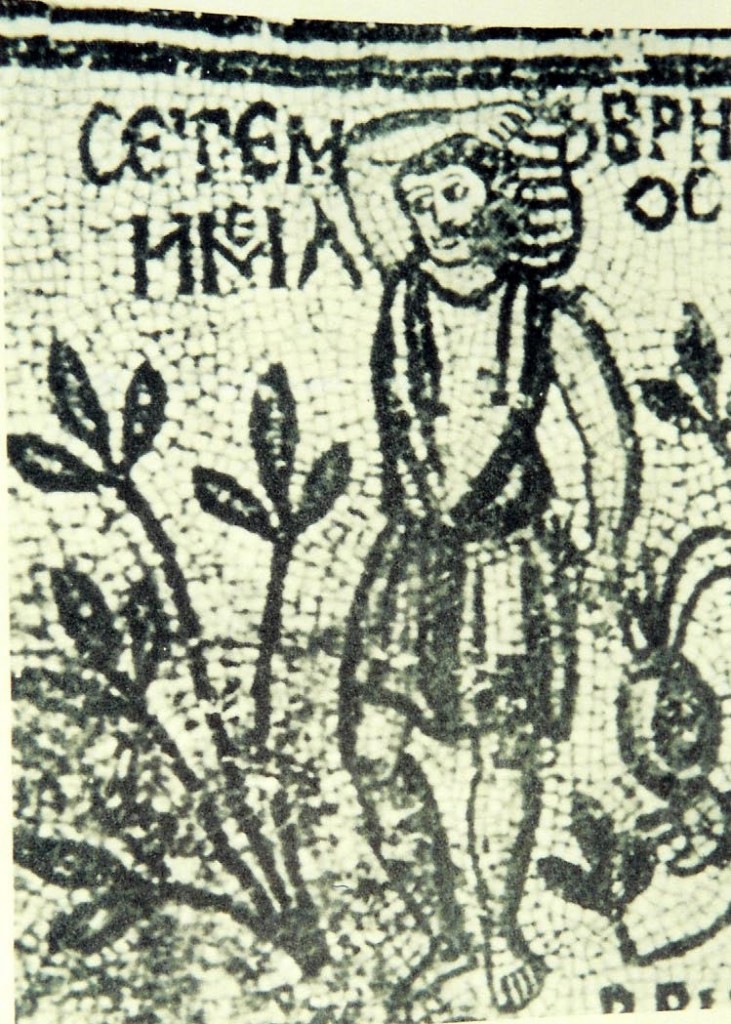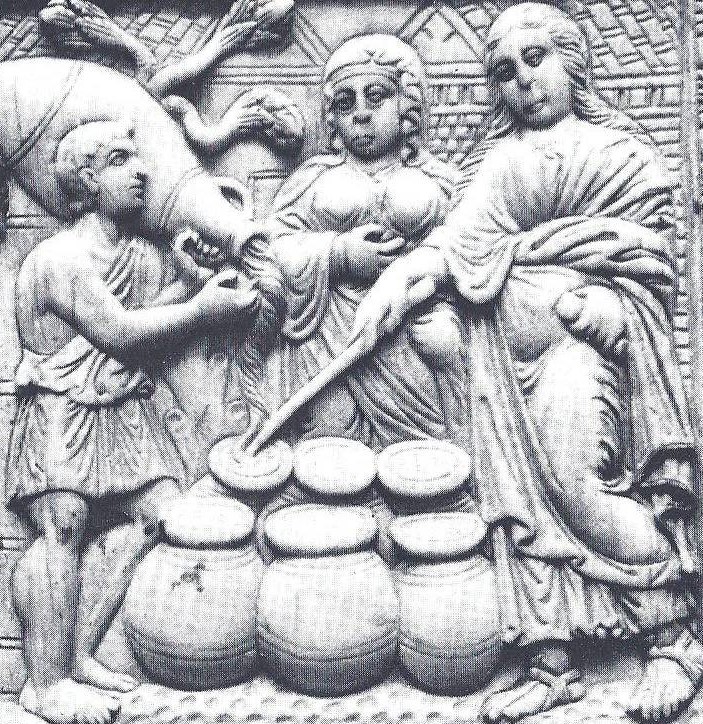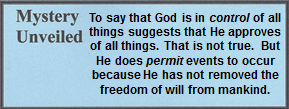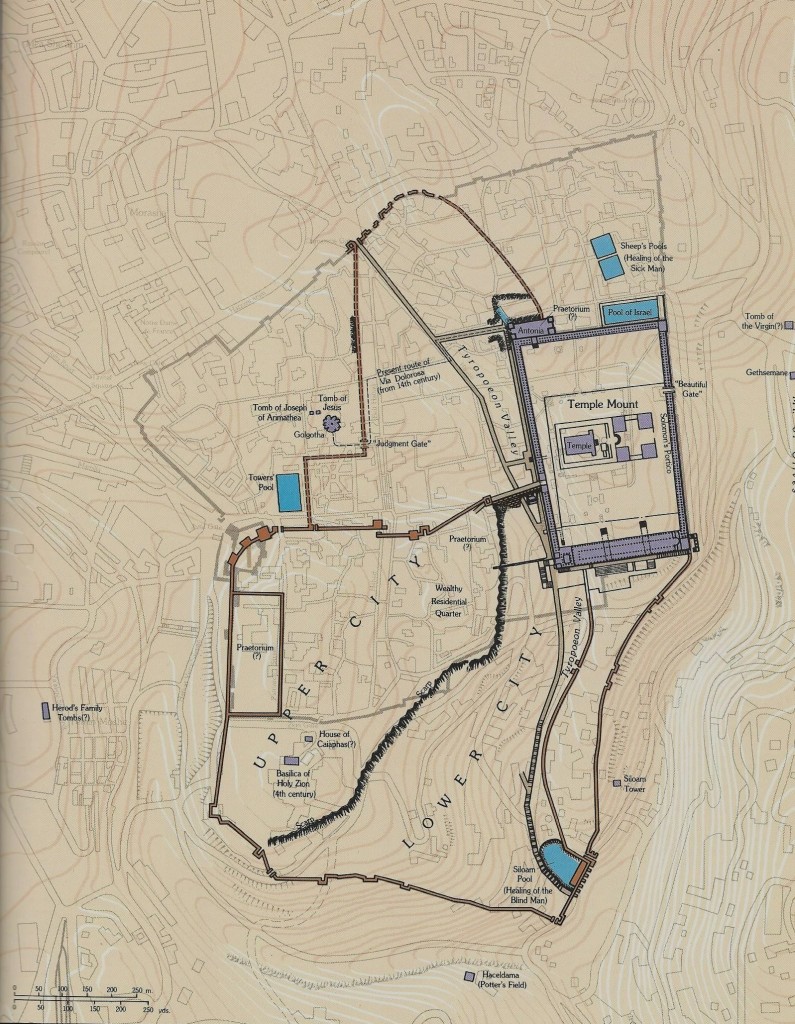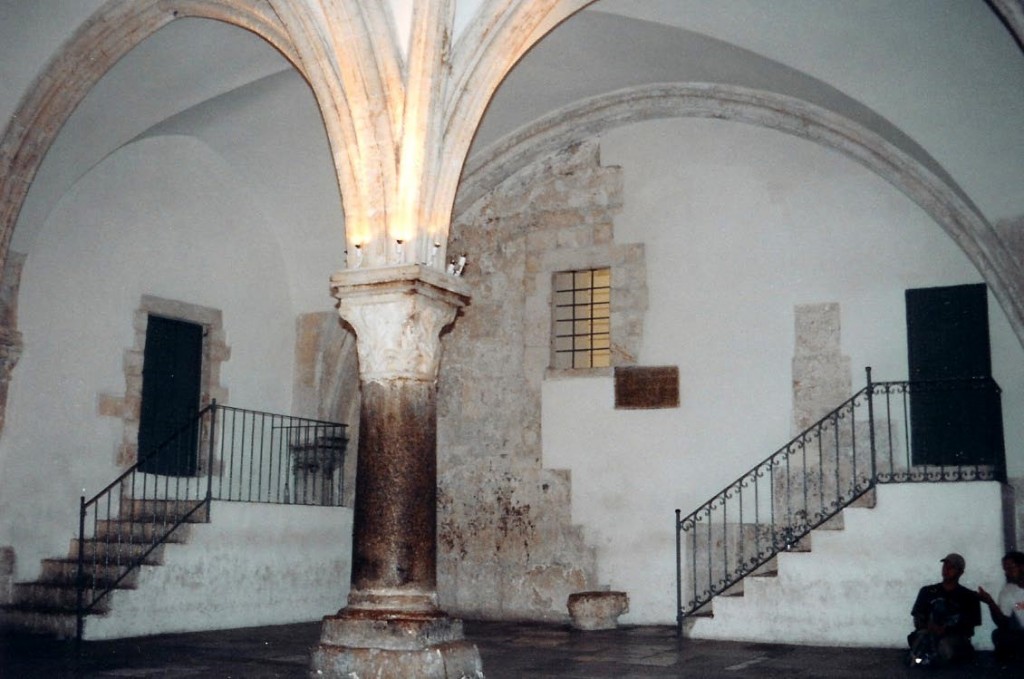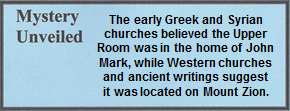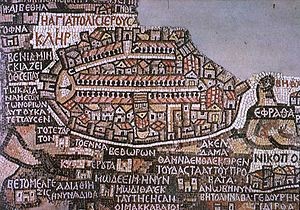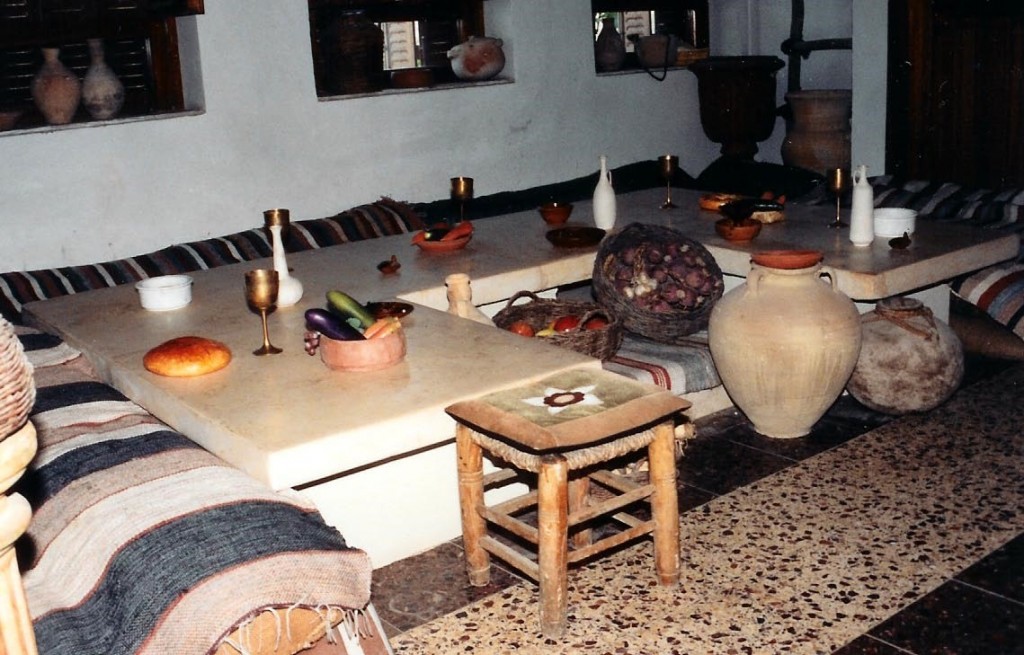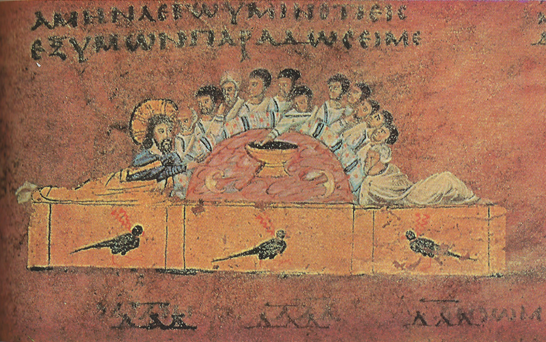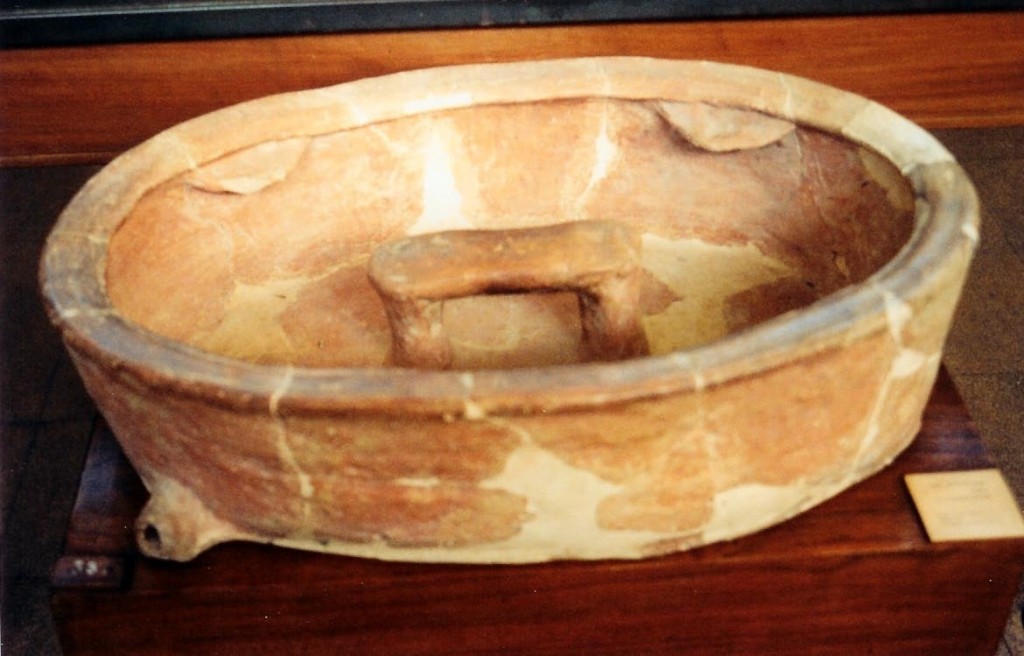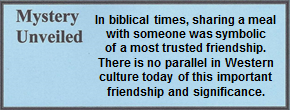14.02.05 Lk. 22:17-20 (See also Mt. 26:26-29; Mk. 14:22-25) The Upper Room:
A MEMORIAL TO JESUS
17 Then He took a cup, and after giving thanks, He said, “Take this and share it among yourselves. 18 For I tell you, from now on I will not drink of the fruit of the vine until the kingdom of God comes.”
19 And He took bread, gave thanks, broke it, gave it to them, and said, “This is My body, which is given for you. Do this in remembrance of Me.”
20 In the same way He also took the cup after supper and said, “This cup is the new covenant established by My blood; it is shed for you.
The Last Supper, or Passover, pointed to three eras or events:
- Past: It memorialized the Exodus and the passing of an old era. This meal reflected upon the protective sacrifice that afforded deliverance and protection to the Israelites at the Exodus (Ex. 12).
- Present: Jesus introduces new meaning even though He is about to face death. This meal points to His death that will also deliver and afford divine protection. The Passover continued in the early church as directed by the Apostle Paul in 1 Corinthians 5:7. The Christian celebration, although without a lamb, was eventually terminated by Emperor Constantine in the early fourth century.
- Future: Finally, the fact that Jesus said that He would not drink of the fruit of the vine until the Kingdom of God comes, means that He will not partake of it until the great Messianic Banquet (cf. 1 Cor. 11:26). In essence, the Passover meal is the “katuvah celebration” between Jesus and His church, similar to the katuvah celebration when a young man and his bride were betrothed some two thousand years ago.
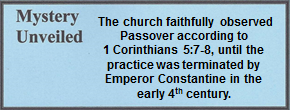
14.02.05.Q1 How was the Passover Seder observed (Lk. 22:17-20)?[1]
The Passover Seder in Jerusalem had to be observed with ten men, although in some other areas, such as Galilee, it was observed with ten people of both genders. The order of the service varied from area to area, but the Seder itself was held in the late evening[2] or night.[3] It was the custom of the time for people to eat two meals a day. The first was mid-morning, reckoned to modern time of 10:00 – 11:00 a.m. and the second was late afternoon. The Passover meal had to be observed in the evening, which some sources state was about 4:00 P.M. but most say after sundown.[4] It was a full meal with a religious ritual, rather than a regular mealtime event.[5] This particular celebration, truly a Passover meal,[6] observed remembrance of the miracle that God provided for the Israelites when He delivered them from the bondage of Egyptian slavery. As part of the observance a lamb was killed in the temple. When it was offered upon the altar, its blood flowed and some was collected to be taken home and sprinkled on the lintel and doorpost of the Jewish home. A part of the lamb would be offered for sacrifice while the rest of it was wrapped in its skin and taken home where it became a part of the Passover meal.[7] When the death angel passed over the homes of the Hebrew children (later called “Jews”) and saw the blood, the life of the eldest child was spared.
The Passover meal included unleavened bread – bread without yeast. It has three symbolic meanings:
- It is “unleavened” because when the Israelites left Egypt, they were in such a hurry that there was not time for the bread to rise.
- The unleavened bread is symbolized as “the bread of affliction” in Psalm 80:5 that they suffered in the days of their slavery.
- This bread is in sharp contrast to the better food that will be enjoyed at the Messianic banquet.
Jesus was about to be killed and His blood was to be shed for the sins of humanity. Those who would accept His forgiveness and follow His ways would have their lives spared from the bondage of sin and death. In memorial to Him the Passover meal, a/k/a the Last Supper, was probably according to this order of service:[8]
- A benediction
- A cup of red wine
- Hands of all present were ceremonially washed as the host passed the water basin and recited a prayer. It was a time to remember tears and sorrows as well as the crossing of the Red Sea. Passover was a personal event – as if God did that incredible sacrifice for every one present.
- Bitter herbs dipped in a hot sauce and eaten.
- A benediction (a blessing, not an ending of a service)
- A second eating of bitter herbs was a reminder of Egyptian bondage.
- A second cup of red wine followed by questions and answers that pertained to the original Passover meal.
- Singing the first part of the Hallel (Ps. 113 – 114)[9]
- A benediction
- The hands of the host are washed. A sop is made by wrapping a bit of lamb with unleavened bread in bitter herbs and dipping it in sauce. Thereafter, everyone followed in turn. The unleavened bread was a reminder of the haste that was made to leave Egypt, so there was no time for bread to rise.
- Each person can eat as much as is desired, finishing the meal with a piece of lamb. However, since lamb is not mentioned and this event occurred before the regularly scheduled Passover meal, some scholars have suggested that there was no lamb served during the Last Supper.
- Again the washing of hands
- The third cup of red wine.
- Singing the second part of the Hallel (Ps. 115-118) which was the conclusion.
- The fourth cup of red wine.
During the Passover, four cups of wine were part of the celebration.[10] The “fruit of the vine” is a Jewish technical term meaning Passover wine that was naturally fermented, not fermented artificially with added sugar or dried fruit. These four cups reflect upon the “I wills” of Exodus 6 and 7, and are as follows:
- The first cup of wine was known as the Cup of Sanctification, a/k/a the Cup of Separation with Thanksgiving, and is based on Exodus 6:6-7. Jesus, as the host, picked up the first cup and gave the ceremonial blessing over the wine by praying, “Blessed are You, Lord, our God, King of the universe, who creates the fruit of the vine.” After this the disciples partook of their cup of wine and Jesus said, “I tell you the truth, one of you is going to betray me” (Jn. 13:21).
Most likely it was at this time that the four traditional questions were asked by the youngest as to the reason for the celebration. A brief account should be given of the bondage that the Israelites had suffered in Egypt centuries past. This must have had a powerful impact, as the disciples would realize that Jesus was applying the Passover motif to deliverance from the bondage of sin. Then Judas realized his sin was discovered.[11]
- The second cup of wine was known as the Cup of Deliverance and Praise, based on Exodus 6:6 (cf Rom. 6:15-18). At the first Passover the Israelites praised God for their deliverance from Egypt. Since then, they were delivered from the Babylonians, Medo-Persians, Antiochus IV Epiphanes and the Greeks, and from numerous other foreign powers. While many suffered, amazingly, there has always been a remnant that survived. No other people group has a parallel history.[12]
- The third cup of wine is known as the Cup of Redemption, based on Exodus 6:6.[13] First, the host of the Passover Seder holds up the unleavened bread, known as the afikomen and prays, “Blessed are You, Lord, our God, King of the universe, who brings forth bread from the earth.” Jesus then took the unleavened bread, broke it and gave it to His disciples, saying, “This is my body given to you” (Mk. 14:22; Lk. 22:19), and “This cup is the new covenant in My blood, which is shed for you” (Lk. 22:20).[14]
The group continued through their Passover meal. He then said, “Do this in remembrance of me.” Believers know this Cup of Redemption as The Communion Cup, because Jesus is their Redemption. The Apostle Paul referred to this cup as “The Cup of Blessings” (1 Cor. 10:10), because of the special blessing that was spoken over it at the end of the Passover meal.[15] By the practice of this ordinance, believers are to remember His suffering death and promised return.[16]
In a similar manner when a young girl accepted the marriage proposal and the katuvah was signed.[17] The next cup of wine would be on their wedding day. When a young man proposed marriage to his future bride, he said,
Be thou betrothed to me with this cup of wine.
Mishnah, Kiddushin 2.2
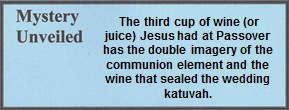
- Finally, the fourth cup of wine is known as the Cup of Acceptance or Cup of Anticipation, a/k/a the Cup of Ultimate Salvation. It is celebrated at the close of the Passover and is close to the Cup of Praise, based on Exodus 6:7. Jesus said specifically that He would not partake of this cup until He and all of His believers are together at the heavenly Messianic Banquet.[18] He told everyone to partake as this was the blood of the covenant which was poured out for many (Mt. 26:27-29; Mk. 14:24).[19] The phrase “poured out” or “shed” is a clear reference to the blood covenant of Exodus 24:4-8 that made God (Yahewh) the God of Israel.[20] This moment must have been stunning for the disciples.
However, the fourth cup of wine has the double meaning of being the cup that will be served at the Marriage Supper of the Lamb, when Jesus and His bride celebrate their wedding. In essence, it is an integral part of the katuvah celebration.
The imagery of Passover – the sanctification, the praise, the redemption, and the acceptance or anticipation – is all within communion when properly understood. All four elements are critical to every believer’s life, but are seldom acknowledged at communion because the Jewish roots of the Christian faith is seldom known, even to experienced pastors.
Concerning wine – the ancients had no method for removing the alcohol content of the wine, but they did dilute it with water. According to the Oral Tradition even the poorest man was to have no less than four cups of “mixed” wine.[21] The wine represented the blood of the Passover lamb and was the ancient symbol for joy.[22] It should be noted that both “spiked” wine and drunkenness were not tolerated and were highly condemned.[23]
The Passover lamb was purchased four days prior to the sacrifice during which time it was tenderly cared for in the home. There it was loved and nurtured, winning the affection of everyone, especially the children. On the fourteenth day of Nisan, a massive slaughter of the Passover Lambs took place inside the temple. It was always painful to see the cute and affectionate lambs get slaughtered, but the object lesson was obvious: The price of sin is always painful and costly.
At the blast of the silver trumpets, the sacrificial lamb was killed by the head of every Jewish family. At all other times the priests slaughtered the sacrifices. A Levitical priest then removed the fat, and burned it. If a bone was broken in this process, the Oral Law demanded that the Levite receive one less than forty stripes, indicating that great care was taken in the punishment/ritual process.[24] During the sacrificial killing, the Levitical choir chanted the Hallel as the congregation repeated the first line of each Psalm after the choir sang it. On the final Psalm (118), verses 25 and 26 were repeated by the congregation.
Its blood was poured out at the foot of the altar. After chanting praises to God, the lamb was taken home to be roasted and consumed as the Passover observation continued in the privacy of a family setting.[25] Technically, according to the Jewish calendar, the lamb was killed one day (before sundown) and eaten the next (after sundown).[26] There were so many men coming to the temple to sacrifice their lambs, that Josephus recorded that the temple gates were opened until after midnight to accommodate the crowds.[27]
It is from the observance of this Passover that the church celebrates Christ in a rite known as “Communion” or “Eucharist” (Gk. give thanks).[28] There are noticeable parallels between the ancient Passover ritual and the introduction of Communion by Jesus.
The Passover The Lord’s Supper
God remembered His covenant. A new covenant is introduced.
Slavery in Egypt remembered Freedom of slavery to sin
Deliverance from Egypt Forgiveness of sins (Mt. 26:28)
Blood of the Passover Lamb The Passover Lamb was symbolic for the
atoned for sins blood of Jesus that removed sins.[29]
Interpretation of the Passover Interpretation of the Lord’s Supper elements
elements
Call for continued celebration Call for continued celebration
Scholars also debate the influence of a community of Essenes in western Jerusalem near the Essene Gate. Josephus identified its location, which assisted archaeologists in uncovering it, but the historian said little else of it.[30] Most scholars believe that Jesus and the disciples celebrated their Passover in an Essene home. There are several considerations for this opinion:
- Some believe that, since the Essenes had separated themselves from mainline Judaism by celebrating Passover a day early, Jesus and His disciples made use of such a facility.[31] They had their own community in the western edge of Jerusalem on Mount Zion.
- There were numerous theological differences and Jesus most certainly would not have been in agreement with the Essenes on many issues.
- Since the Passover meal was only between Jesus and His disciples, the observance could have been held anywhere.
- It was most important for Jesus to die on the cross at the same time that Passover lambs were sacrificed in the temple. Therefore, Jesus and His disciples had to have had their Passover lamb early, since it was impossible to observe Passover without a lamb in the Second Temple Period.
There is another debate among scholars as to whether the name of this Essene gate was derived from Essenes residents or from the road leading from the gate to Qumran where a number of Essenes lived. Frequently, a gate was named for the distant city to which the road from the gate led. For example: the road from the Damascus Gate led to Damascus and the road from the Jaffa Gate led to the seaport town of Jaffa.[32] However, not all gates have such honors, such as the Dung Gate or the Sheep Gate. In all probability, this gate was named because there were Essenes living in the adjacent area as well as the road that led to the Qumran community by the Dead Sea.
Video Insert >
14.02.05.V1 The Last Passover and Possible Connection to the Essene Calendar. Dr. Paul Wright discusses the “biblical difficulty” of Jesus celebrating the Passover the day before most other Jews celebrated it. Did Jesus observe the Passover according to the Essene Calendar?
As previously stated, there were regional variations of the Passover observances. The Mishnah, for example, states that on the 14th day of Nisan the people of Judea worked until noon, while in Galilee there was no work to be done at all.[33] Finally, the early church celebrated Passover (without the lamb) and communion for three centuries, until the practice was decreed to be illegal by Constantine the Great, who was also largely responsible for removing the last traces of Jewishness from Christianity. Until the year 325 the church fathers understood the words of Paul to be taken literally when he said,
Therefore, let us observe the feast, not with old yeast or with the yeast of malice and evil but with the unleavened bread of sincerity and truth.
1 Corinthians 5:8
These Passover-observing Christians were called the Quartodecimians or Fourteeners, by Hellenistic Christians who had no understanding of the significant meaning of Passover in Jews’ or Christians’ lives.[34] In so doing Paul implied the apostles should maintain the liturgical Jewish calendar.[35]
There are two final thoughts to be discussed. Throughout history whenever the Jews observed the Feast of Passover and recalled their flight from Egypt, they did not use terms such as “our forefathers,” “our ancestors,” or “them.” They used the personal pronoun “us,” and, thereby, identified themselves as the recipients of God’s deliverance. In fact, they personalized the Bible as if it was written specifically for each family. Likewise, Jesus affirmed and continued the personalized element of the Passover/Last Supper Communion celebration.
Not everyone who claimed to be a believer was permitted to participate in the Lord’s Supper, that is, the Communion / Eucharist. It must be noted that Matthew 7:6 (08.04.04) quickly became a significant guidepost for admitting some and prohibiting others from attending the sacred ritual. Church growth was exploding and many false teachers entered various congregations causing chaos and confusion. Tertullian complained that popular false teachers and heretics permitted everyone to our Lord’s Table, similar to “Open Communion” practiced by many churches today. He said,
That which is holy they will cast to the dogs, and pearls to swine.
Tertullian, De Praescriptione 41
The early church not only underscored the exclusiveness of the Lord’s Table, but also made a reference to Matthew 7:6 as follows.
Let no one eat and drink from your Eucharist but those baptized in the name of the Lord: to this, too, the saying of the Lord is applicable, “Do not give to dogs what is sacred.”
Didache 9:5[36]
The early church did not observe “Open Communion,” whereby anyone who said they were a believer could participate. Being a Christian was too dangerous to permit any stranger be part of the believer’s circle. The gospel message was available to everyone. However, to become a part of the inner-circle of believers and partake of the Communion Table, one had to show evidence of a changed and consecrated life. While the Didache states that all those who participate in Communion should be baptized, the cultural context of the entire passage restricts Communion to only those who were baptized and live an obedient lifestyle.[37] It has been said that the challenges that the first century church faced immediately after Jesus returned to heaven will be the same immediately before He returns. If so, then church leaders today may need to re-evaluate their open communion policies.
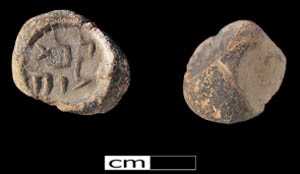
14.02.05.A. SECOND TEMPLE PERIOD SEAL CERTIFIED TEMPLE SACRIFICE. In 2011 archaeologists excavating at the Robinson’s Arch section of the Temple Mount, discovered a small clay seal with the inscription “Pure for God.” It is believed that when a worshiper had his sacrificial offering inspected and approved, he was given a seal like this one to carry with his sacrifice to a priest at the altar.[38]
While the theme and basic structure of the Passover Seder (Passover Service) was standardized, there were regional variations. There is no consensus on the format of a first century Passover and, quite possibly, this is because of variations that existed within Judaism. Jewish scholars have cataloged more than 1,600 forms, three basic elements have remained consistent:
- The bread is unleavened,
- The bread is striped, and
- The bread is pierced.
Jesus was symbolized in the bread in that He was sinless (unleavened), He was scourged with a Roman whip (striped), and He was pierced with a Roman sword and nails. Two writers of antiquity preserved valuable details – first Josephus followed by one of the writers of the Mishnah:
In the month of Xanthicus, which is by us called Nissan, and is the beginning of our year on the fourteenth day of the lunar month, when the sun is in Aries (for in this month it was that we were delivered from bondage under the Egyptians), the law ordained that we should every year slay that sacrifice which I before told you we slew when we came out of Egypt, and which was called the Passover; and so do we celebrate this Passover in companies, leaving nothing of what we sacrifice until the following day. The feast of unleavened bread succeeds that of Passover and falls on the fifteenth day of the month and continues for seven days, wherein they feed on unleavened bread. On every one of which days two bulls are killed and one ram and seven lambs. Now these lambs are entirely burnt beside the kid of the goats, which is added to all the rest, for sins. For it is intended as a feast for the priest on every one of those days. But on the second day of unleavened bread, which is the sixteenth day of the month, they first partake of the fruits of the earth for before that day they do not touch them. And when they supposed it proper to honor God, from whom they obtain this plentiful provision in the first place, they offer the first fruits of their barley, and that in the following manner: They take a handful of the ears and dry them, then beat them small and purge the barley from the bran. They then bring one-tenth deal to the altar to God, they leave the rest for the use of the priest and after this, it is that they may publicly or privately reap their harvest. They also at the participation of the first fruits of the earth, sacrifice a lamb as a burnt offering to God.
Josephus, Antiquities 3.10.5 (248-251)
On the eve of Passover, from about the time of the Evening Offering a man must eat nothing until nightfall. Even the poorest in Israel must not eat unless he sits down to table, and they must not give more than four cups of wine to drink, even if it is from the (Pauper’s) Dish.
After they have mixed him his first cup, the School of Shammai says: he says the benediction first over the day and then the Benediction over the wine. And the School of Hillel says: he says the Benediction first over the wine and then the Benediction over the day.
When (food) is brought before him he eats it seasoned with lettuce, until he is come to the breaking of bread; they bring before him unleavened bread and lettuce and the haroseth (the mixture of nuts, fruit, and vinegar), although haroseth is not a religious obligation. Rabbi Eliezer ben Rabbi Zadok says: It is a religious obligation. And in the holy city, they used to bring before him the body of the Passover-offering.
They then mix him the second cup. And here the son asks his father (and if the son has not enough understanding his father instructs him how to ask), “Why is the night different from other nights? For on other nights we eat seasoned food once, but this night twice; on other nights, we eat leavened or unleavened bread, but on this night all is unleavened; on other nights we eat flesh roast, stewed, or cooked, but this night all is roast.” And according to the understanding of the son his father instructs him. He begins with the disgrace and ends with the glory; and he expounds from a wandering Aramean was my father … until he finishes the whole section (Deut. 26:5-11).
Rabban Gamaliel used to say; “Whoever had not said (the verses concerning) these three things at Passover has not fulfilled his obligation. And these are they: Passover, unleavened bread, and bitter herbs: ‘Passover’ – because God passed over the houses of our fathers in Egypt; ‘Unleavened bread’ – because our father was redeemed from Egypt; ‘Bitter herbs’ – because the Egyptians embittered the lives of our fathers in Egypt. In every generation a man must so regard himself; as if he came forth himself out of Egypt, for it is written: “And you shall tell your son in that day saying, ‘It is because of that which the Lord did for me when I came forth out of Egypt. Therefore are we bound to give thanks, to praise, to glorify, to honor, to exalt, to extol, and to bless him who did all these wonders for our fathers and for us. He brought us out of bondage to freedom from sorrow to gladness, and from mourning to a festival-day, and from darkness to great light, and from servitude to redemption, so let us say before him the Hallelujah.
How far do they recite (the Hallel, i.e. Ps. 113-118) the School Shammai say: “To a joyful mother of children” (end of Ps. 113). And the School of Hillel says: “To a flintstone into a spring well” (end of Ps. 114).[39] And this concluded with the Ge’ullah (a benediction). Rabbi Tarfon says: “He that redeemed us and our fathers from Egypt and brought us to this night to eat therein unleavened bread and bitter herbs.” But there is no concluding Benediction. Rabbi Akiba adds: “Therefore, O Lord our God and the God of our fathers, bring us in peace to the other set of feasts and festivals which are coming to meet us, while we rejoice in the building – up of your city and are joyful in your worship; and may we eat there of the sacrifices and of the Passover-offerings the wall of your altar and let us praise you for our redemption and for the ransoming of our soul. Blessed are you, O Lord who redeemed Israel.”
After they have mixed for him the third cup he says the Benediction over his meal. (Over) a fourth (cup) he completes the Hallel and says after it the Benediction over song. If he is minded to drink (more) between these cups, he may drink; only between the third and the fourth cups he may not drink.
After the Passover meal they should not disperse to join in revelry.
Mishnah, Pesahim 10.1-8[40]
It should be noted that both the circumcision and Passover symbolized the covenant God had with the Israelites. The Passover is the memorial of when God saved the lives of Jews as He led them out of Egyptian bondage and, eventually, into the Promised Land. Circumcision was symbolic of the covenant relationship between God and man, which was to be passed on from generation to generation, because the promises of God were to Abraham and to all of his descendants. Therefore, no uncircumcised Jew or non-Jew was permitted to participate in the Passover event (Ex. 12:48). It appears that both rites were suspended during the forty year desert wandering, but resumed when the Israelites entered the land of Canaan (Num. 9:2). No explanation was given for its forty year discontinuance. It should also be noted that there was no sacrificial lamb during the previous exilic times. But by the first century so many Jews were living hundreds of miles from Jerusalem that the rabbis decreed every Jew needed to visit Jerusalem only once in a lifetime.[41]
“For I tell you, from now on I will not drink of the fruit of the vine.” By this statement Jesus said He would wait for His bride until the Kingdom of God is completed. The imagery of this cup of wine was that of a bridegroom offering a cup of wine to his bride, when the katuvah was signed (a new covenant). The couple shared the third [Passover] cup of wine on their wedding day. The fourth cup of wine is the last of the Passover cups and has the double meaning of being the cup that will be served at the Marriage Supper of the Lamb, when Jesus and His bride celebrate their wedding. This Passover meal concluded with a dramatic change from the customary closing. Jesus offered bread and wine to His disciples and stated that these elements were to be symbolic of Him, the new covenant, and in remembrance of Him. In later years, the observance of wine and bread became known as “Communion” or “Holy Eucharist.”
In the timeline of God, there are “Three Great Passovers” to be considered, and understanding these provides full meaning of this special and sacred observance.
- The Passover of Egypt when God brought His people out of Egyptian slavery and out of the environment of Egyptian gods.
- The Passover of the Last Supper when Jesus not only connected His life to the first Passover, but also “sealed the marriage katuvah” with his bride.[42]
- The Messianic Banquet is not a Passover, but there are clear resemblances to a Passover as well as to a first century wedding.
The term the “Lord’s Supper” is used only once in the New Testament (1 Cor. 11:20). It reflects the special nature of the event in the early church. The common word eucharistic, meaning thanksgiving, was not used until the time of Ignatius in the early second century.[43] While the Eucharist / Communion is certainly something to be revered and be thankful for, unfortunately, the church has lost the full meaning of it.
Video Insert >
14.02.05.V2 The Imagery of the Passover and Last Supper in the Messianic Wedding Banquet. Professor John Metzger discusses the purity of the (L)lamb during the Passion Week and the related imagery of the bride and groom to the Messianic Wedding Banquet.
“This is my body.” The Passover bread was the emblem, or representation of His body that is a figure of speech. In essence, bread is the all inclusive term meaning all that is required to live – the substance of life is Jesus.[44] A similar literary style is found in Deuteronomy 32:4. Other examples are these: In that passage Moses said the “He is like a rock,” the pictorial imagery of the Hebrew Law becomes quite evident. In John 15:5 Jesus said that “I am the vine and you are the branches,” obviously not literally, but represented by the vine and branches. In this passage, Jesus represented His “body” and “blood” with the emblems of bread and wine (or grape juice). Israel had been the vine, into which all people had to connect to worship God. But when Jesus said, “I am the vine,” He clearly stated that He was the only way to God the Father and eternal life in heaven.
Throughout church history the phrase has been defined as “this represents my sacrifice,” as well as “this is myself.”[45] These words are a metaphor, as underscored by the Apostle Paul: “This is my body which is for you; do this as my memorial.” The blood of Jesus was a clear reflection upon the first Passover, when Moses sprinkled the blood of a lamb on the door openings of the Jewish homes, so that the death angel would pass over them. He said, “This is the blood of covenant which the Lord has made with you in accordance with all these words” (Ex. 24:8). If the words of Jesus were taken literally, they would state that the church is an extension of the incarnation, which is obviously not true.[46]
Holy Communion consists of bread and wine (or grape juice). In the Old Testament, bread was symbolic of God’s provision to His people and wine was symbolic of His joy for those who would be in the Messiah’s kingdom. The imagery was the same during the Passover celebration.[47] In the millennial reign Israel will offer sacrifices as memorials of the death of Jesus (Ezekiel 46:13-25), while the church will memorialize the death with the breaking of bread and drinking from the cup, as described by the Apostle Paul:
23 For I received from the Lord what I also passed on to you: On the night when He was betrayed, the Lord Jesus took bread, 24 gave thanks, broke it, and said, “This is My body, which is for you. Do this in remembrance of Me.”
25 In the same way, after supper He also took the cup and said, “This cup is the new covenant established by My blood. Do this, as often as you drink it, in remembrance of Me.” 26 For as often as you eat this bread and drink the cup, you proclaim the Lord’s death until He comes.
27 Therefore, whoever eats the bread or drinks the cup of the Lord in an unworthy way will be guilty of sin against the body and blood of the Lord.
1 Corinthians 11:23-27
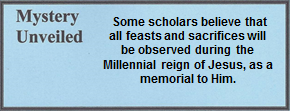
Here lies an interesting illustration between the proverbial “old law” of the Hebrew Bible and the “new law” of the New Testament. The Apostle Paul said the believer was to come to the communion table with a pure heart (1 Cor. 11:27). Anyone who comes to partake of the bread and of the fruit of the vine is to first resolve all conflicts with his fellow man, before he can come into the presence of God. When a Jew came to the mikvah, he or she immersed in the water before entering into the presence of God in the temple.[48] The Jews, however, also recognized that the ritual bath was symbolic of what was to be in the heart, for the twelfth century rabbinic scholar Maimonides said, “Now ‘uncleanness’ is not a matter of mud or filth which water can remove, but is a matter of scriptural decree and dependent on the intention of the heart.”[49] So likewise, prior to coming to the communion table, believers are to resolve their differences before entering into the presence of our Lord in their fellowship. Finally, it is interesting that there is no mention of a Passover lamb in the gospel narratives. Most certainly there was a lamb or it would not have been a true Passover. The reason for the omission maybe that the last supper would be continued under the name of “communion” wherein Jesus is worshiped for being the Passover Lamb who was sacrificed for the sins of the world.
“This cup is the new covenant established by My blood; it is shed for you.” The Greek word for covenant in this phrase, diatheke is not the word used when there is an agreement between equals (which is suntheke), but the word for covenant between a superior benefactor and his inferior servant.[50] A diatheke covenant is the type of covenant whereby a group of people will bind themselves to a king or protector. This diatheke covenant is the fulfillment of the prophecy given by Jeremiah.
“Look, the days are coming”— this is the Lord’s declaration — “when I will make a new covenant with the house of Israel and with the house of Judah.”
Jeremiah 31:31
The Apostle Paul said in 1 Corinthians 11:25, where he quoted Jesus, that the commemorative communion, is the new covenant. It also looks back into history upon the sacrifice of Jesus and His death and resurrection, while it looks forward to the marriage feast (a covenant feast celebration) in the heavenly Kingdom of God (Mt. 26:29).
Covenants were strong and powerful agreements between two partners and were made with the promise of death to the one who would break it. Jesus made the new covenant and then died on our behalf, because believers break covenants daily. The phrase “My blood, which is poured out for you,” or “My blood; it is shed for you,” is reflective of the covenant established between God and Moses on Mount Sinai (Ex. 19-24). After Moses encountered God, he and the people built an altar at the foot of the mountain and sacrificed an animal. Moses poured out half of the blood upon the base of the altar and the other half he sprinkled upon the people.[51] The Last Supper was and continues to be a perfect “type and shadow” of the sacrificial offering made by Moses fifteen centuries earlier (cf Ex. 19-24; Heb. 8:8-12).[52]
When Jesus referred to “His blood,” He used the phrase figuratively just as bread was used figuratively concerning His body. It was not blood which they drank, as is evident from the fact that later he called it “the fruit of the vine.” The wine or grape juice was the emblem of His blood which was soon to be shed for many.
[1]. See video comments by messianic scholar Timothy Hegg in 01.01.02.V.
[2]. See discussion on “evening” in Appendix 16.
[3]. 1 Cor. 11:23; Jn. 13:30; Mk. 14:17; Mt. 26:20.
[4]. Ex. 12:8; Mk. 14:17; 1 Cor. 11:23.
[5]. Stein, R. Jesus the Messiah. 203.
[6]. Mt. 26:2, 17-19; Mk. 14:1, 12, 14, 16; Lk. 22:1, 7-8, 13, 15.
[7]. Pentecost, The Words and Works of Jesus Christ. 423-23.
[8]. Pentecost, The Words and Works of Jesus Christ. 427; Stein, R. Jesus the Messiah. 204-05. It is not surprising that scholars may have differences of opinion on how the Passover was celebrated. Even in the first century, there were variations throughout the Mediterranean area. A slightly different Seder order of service is presented by Fruchtenbaum, The Jewish Foundation of the Life of Messiah: Instructor’s Manual. Class 22, pages 5-13.
[9]. For identifying the connections of Jesus with the Hallel (Ps. 114-118), see 04.06.01.
[10]. Stahler, “The Four Cups.” 14-16; Geikie, The Life and Words of Christ. 1:216-18.
[11]. Pixner, With Jesus in Jerusalem. 93.
[12]. Geikie, The Life and Words of Christ. 1:218-222.
[13]. See also Lk. 22:20; 1 Cor. 11:23-26; Gal. 4:4-7.
[14]. See interesting comments by Messianic scholar Timothy Hegg concerning the third cup in 01.02.01.V.
[15]. Edersheim, The Life and Times of Jesus the Messiah. 827.
[16]. Other references that pertain to Holy Communion are Lk. 22:19-20; Mt. 26:26-28; Mk. 14:22-25; Jn. 6:48-58; 1 Cor. 11:23-39.
[17]. The marital contract is further described in 04.03.03.A and 08.02.01.
[18]. See 1 Cor. 15:50-55; 2 Cor. 5:17-21.
[19]. Mendenhall, “Covenant.” 1:722.
[20]. Guhrt, “Covenant, Guarantee, Mediator.” 1:365-66.
[21]. Mishnah, Pesahim 10:1-2, 4, 7.
[22]. Rosen and Rosen, Christ in the Passover. 50-51.
[23]. “Spiked wine” was wine with added sugar or dried fruit that increased the alcohol content, and was known as “strong drink.” See Appendix 26.
[24]. Mishnah, Pesahim 7:11.
[25]. Rosen and Rosen, Christ in the Passover. 46-48.
[26]. Bloch, The Biblical and Historical. 101. Sunset was deemed to be the end of one day and the beginning of the next day.
[27]. Josephus, Antiquities 18.2.2.
[28]. Stein, R. Jesus the Messiah. 205.
[29]. See 1 Cor. 5:7; Jn. 1:29, 36.
[30]. Josephus, Wars 5.4.2 (145).
[31]. Hoffman, “The Bread of Sacrifice.” Vol. 2 Part 4.
[32]. Those who oppose the position that Jesus celebrated Passover in the Essene community of western Jerusalem cite that there is no archaeological evidence that the Essenes lived there. However, the Essene lifestyle was such that there would not have been any identifiable differences of a material nature or archaeological evidence. As to the date or location of the Passover, they are resolved that it remains a mystery.
[33]. Mishnah, Pesahim 4:5.
[34]. Garr, Restoring Our Lost Legacy. 143-45.
[35]. Garr, Restoring Our Lost Legacy. 155-56.
[36]. The Didache is a book on church order that was written within a century of the life of Jesus. For more information, see 02.02.08.
[37]. Pilch, The Cultural Dictionary of the Bible. 94.
[38]. http://www.biblicalarchaeology.org/daily/news/jerusalem-seal-gives-evidence-for-temple-ritual/?mqsc=E3013909 Retrieved December 27, 2011.
[39]. Today Bibles have the convenience of chapter and verse divisions. Most historical sources credit Stephen Langton (1150-1228) for placing chapter divisions in the Vulgate Bible in the year 1228. Therefore, the ending of these readings was indicated by the quotation.
[40]. Insertions by Danby, ed., Mishnah.
[41]. Bloch, The Biblical and Historical. 104, 106, 109.
[42]. The marital contract is further described in 04.03.03.A and 08.02.01. See also the video 09.03.04.V1 by Rabbi John Fischer who discusses first century wedding imagery.
[43]. Wigoder, “Last Supper.”
[44]. Cranefield, “Bread.” 37.
[45]. Some Christian denominations believe that the bread and wine literally and miraculously turn into the flesh and blood of Jesus.
[46]. Kaiser, Davids, Bruce, and Brauch. Hard Sayings of the Bible. 449; Farrer, “Body of Christ.” 1:203.
[47]. Pentecost, The Words and Works of Jesus Christ. 432.
[48]. Zondervan’s New International Version Archaeological Study Bible. (2005, ed.). 1562.
[49]. Maimonides. Book of Cleanness. 526., quoted by William Sanford La Sor in “Discovering What Jewish Miqva’ot Can Tell Us About Christian Baptism.” 52, 84.
- Ladd, Biblical Expositor. 3:67; Lang, Know the Words of Jesus. 356; Barclay, A New Testament Wordbook. 30-32.
[51]. For a study of Jewish covenants from a messianic Jewish perspective, see Arnold Fruchtenbaum, Israelology: The Missing Link in Systematic Theology.
[52]. Saldarini, Jesus and the Passover. 60. See Appendix 6 concerning Old Testament sacrifices and Jesus. Appendix 9 reveals the New Testament plan of salvation as presented in the Old Testament. See Appendix 3 for a comparison of Moses as a prophetic picture of Jesus. See also “type and shadow” in Appendix 26.
